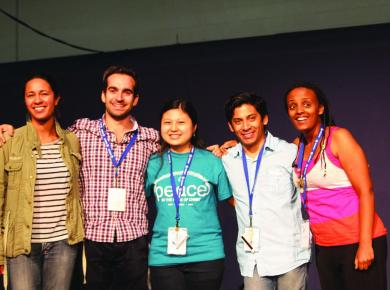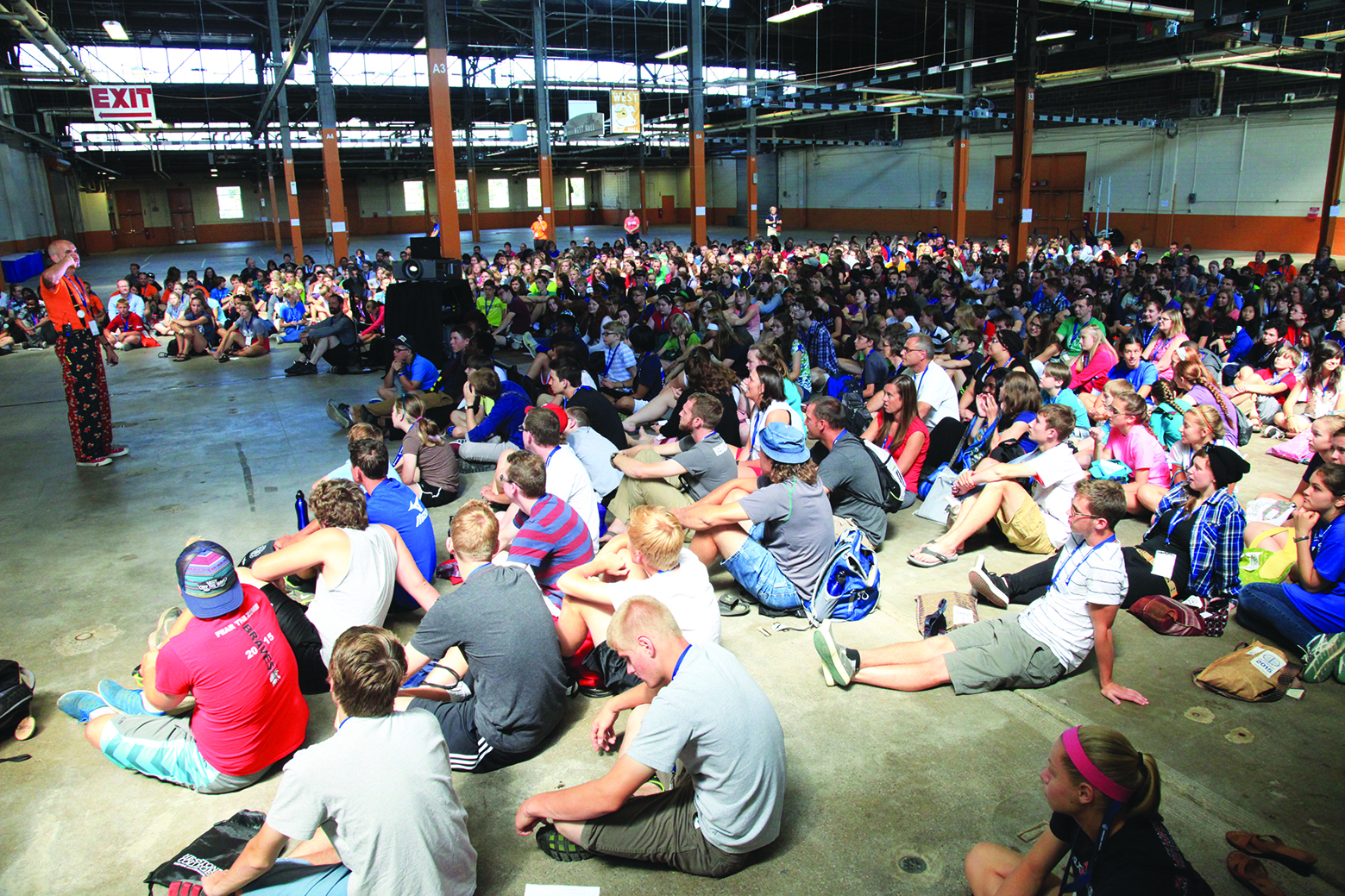Posted: May 19, 2016
YABs take the stage at PA 2015 and set plans for their future
They have a relatively short history, but their voices at PA 2015 were arresting and incisive.
In fact, the Young Anabaptists’ presentations throughout the morning worship at the Assembly caused some of the most spirited conversation at the Farm Show Complex (FSC) and were shared and discussed extensively on social media and beyond.
Known as YABs, these representatives of young people in Mennonite World Conference (MWC) member churches told the truth in unmistakably clear language. They asked strong questions. They were inspirational in their convictions.
This was not by chance. The members of the YABs Committee, who provide leadership for YABs activities and their mission, are a disciplined, seasoned group. Average age: 28½.
The YABs started in 2003 just before the MWC Assembly in Bulawayo, Zimbabwe. More than 220 young people (ages 18–30+) from 28 countries gathered for the first Global Youth Summit (GYS), designed for fellowship and networking.
The get-together was so satisfying and so stretching for those who came that the young leaders asked that a second GYS be planned.
Elina Ciptadi-Perkins of Indonesia says, “While we were together in Bulawayo, we called for ongoing representation within MWC. We wanted to create a leadership group of five young people to initiate and implement our presence, with one representative each from Latin America, Asia, Africa, Europe and North America.”
Ciptadi-Perkins, a delegate in 2003 from the GKMI national Mennonite conference in Indonesia, was appointed leader of the group, known then as the Amigos.
The third GYS, which more than 400 attended, was held at Messiah College in Grantham, Pennsylvania, USA, 17–19 July 2015, just before the MWC Assembly in Harrisburg. Following the events, Ciptadi-Perkins, still a strong advocate for the YABs, reflected with two current members of the YABs leadership committee, Rodrigo Pedroza of Mexico and Marc Pasqués of Spain and Australia, about the YABs today.
“We came more prepared than ever to the 2015 GYS. We had surveyed young adults in our individual countries. Their requests and wishes guided our worship, our seminars, our games and our down time while we were together,” says Pedroza.
But the YABs also came prepared to the Assembly which followed at the FSC. “In Zimbabwe in 2003, we young people were given a verse to read in the main sessions. In the past, people saw us youngs as ‘creative’ and ‘full of energy.... Maybe they could do some music.’ But here at PA 2015, YABs had a key part in every single morning of the Assembly,” says Ciptadi-Perkins.
“People now see we have the gift of discernment and critical thinking. We want to work together with our older sisters and brothers. Now it’s becoming a dialogue,” she says.
In some countries, YABs carry major church responsibilities. “Half of the ministers in Mexico are young people,” says Pedroza, chair of the YABs Committee and one of the morning speakers at PA 2015. “The Mennonite churches in Mexico have abandoned bureaucracy, so young people are quite involved.
“In my country, Anabaptism’s ideals have been lost generation by generation. Our older leaders haven’t been teaching it, favouring instead a charismatic approach and Pentecostalism,” says Pedroza. We’re helping to put Anabaptism into practice and discovering its freshness.”
Marc Pasqués was first invited to be a YABs delegate at the second GYS held in Paraguay in 2009. “Marc’s national church conference was affirmed as a member of MWC just before the Assembly in Paraguay,” remembers Ciptadi-Perkins. “In addition to Marc’s evident skills, we invited him as encouragement to his conference to immediately be connected to the global church.”
The YABs Committee includes one representative from each of the five continents, plus the MWC staff mentor. Members who completed a term at PA 2015 are Rodrigo Pedroza, Mexico; Tigist Tesfaye Gelagle, Ethiopia; Sumana Basumata, India; Marc Pasqués, Spain/Australia; Lani Prunés, US; and Ayub Omondi, Kenya, as mentor.
YABs leaders have had unusual vision from the group’s very beginning. “Our first team planted the seeds about how we young people could contribute to MWC,” says Ciptadi-Perkins.
“Our second team met with different official groups within MWC, explained who we are and what our gifts are, and asked for greater collaboration. This was our penetration stage. We wanted to go beyond token participation. “Since Paraguay, we’ve been putting together our blueprint.”
“We’ve always had a strong desire to network and fellowship. Many of us had email, but back then, not many in the Global South had regular access. This past reality is changing now.”
Pedroza continues, “Now we are threading those deep interests through the projects we are creating since they are a key part of our blueprint.”
“Our projects are for the people we represent, but also for younger people who want to be connected. In smaller churches around the world, age distinctions aren’t as important,” says Tigist Gelagle. “We are designing specific activities for them to do, while at the same time, exposing them to each other’s worlds. And through it all will be the great reminder: ‘You belong to a bigger family. You are not alone.’
“We’re preparing teaching materials for the book of Acts. It will be a Bible study that examines the text. But it will also weave in an explanation of Anabaptism. And it will show how to integrate Anabaptist understandings of the Bible into one’s culture.”
The YABs Committee has also been giving careful attention to its own growth as leaders. Ciptadi-Perkins says, “When we began, we needed a lot of ‘envisioning.’ We didn’t have experience being part of multicultural groups and settings. We had tensions that could
have been avoided had we been forewarned. Some MWC leaders helped us, but none was specifically assigned to give us this kind of guidance.
“So after the GYS in Paraguay, we decided to bring two members from the previous committee to the new team to talk about personal communication styles, and to help us understand each other better so we could avoid wasting time and energy in conflict.
“We also named a mentor from an earlier YABs Committee who would give us tools for organizing ourselves and our work. We have learned that the mentor role is very important.”
“We do not want to be the future of the church anymore,” says Pedroza emphatically. “We want to be the present church. They finally believe in us. They trust us. We need to use this opportunity to be listened to – wisely.
“We need to continue to be respectful of each other. We are different. We think differently. But we need each other. For example, we must keep our peace convictions alive, especially when we’re at home and not together.”
“My prayer,” says Ciptadi-Perkins, “is that young people don’t become complacent. Things could now seem easy since we were taken seriously at PA 2015. I hope this doesn’t become ‘expected without work and effort.’”
- Phyllis Pellman Good is a writer and editor from Lancaster, Pennsylvania, USA.
This article first appeared in Courier/Correo/Courrier October 2015
Young Anabaptists-to-be had their own programming during Assembly to explore the theme “walking with God” in sessions for children and teenagers. Photo: Jonathan Charles
Click on the photo to see the high resolution version.




Comments: